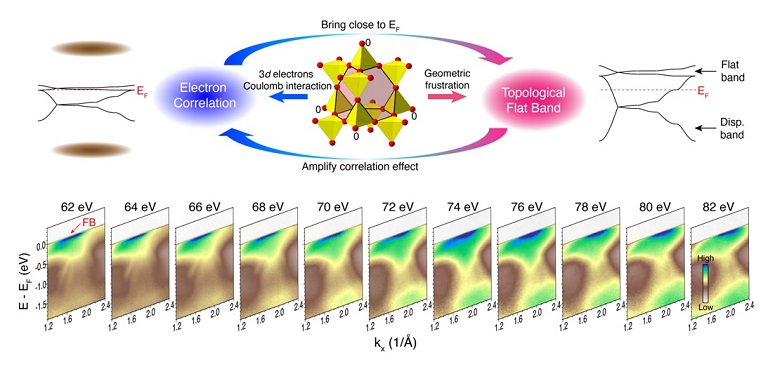Topological flat bands in quantum materials represent a fascinating subject in condensed matter physics, often associated with numerous exotic phenomena, including superconductivity, magnetism, and charge density wave order. Flat bands are commonly found in quantum materials where the Coulomb interactions are comparable to or larger than the electron kinetic energy. In such a regime, the electrons are slowed down significantly such that they interact strongly with each other and hence form emergent electronic orders that could change the macroscopic material properties. In contrast to the narrow bands produced by electron Coulomb interactions that reduce the electron velocity, topological flat bands originate from the quenching of kinetic energy due to the quantum destructive interference of the electronic wavefunction. Searching for flat bands in real materials and uncovering the related intriguing phenomena as well as the underlying microscopic mechanisms are collectively referred to as flat band physics.
To realize flat band physics in a system, besides finding the proper material conducive to flat band formation, two requirements are considered critical. Firstly, the flat band needs to exhibit flatness across large momentum space. Secondly, the flat band needs to be positioned in proximity of the Fermi level (EF) to contribute to the macroscopic physical properties.
Kagome metals, as a type of geometrically-frustrated lattice materials, have served as a natural platform for hunting for flat bands. The kagome lattice consists of corner-sharing triangles and hosts flat band due to the destructive interference of the electron wavefunctions inherent in the geometrically-frustrated lattice. However, flat bands in most known kagome materials are far away from EF, hindering their involvement in low energy physics that could influence the macroscopic material properties. In addition, the flatness of the band is often disrupted along the momentum path perpendicular to the kagome plane due to the non-negligible interlayer hopping.
To address the aforementioned issues concerning flat band physics, researchers from Rice University and SSRL conducted an angle-resolved photoemission spectroscopy study on a three-dimensional (3D) geometrically-frustrated material in collaboration with scientists from the University of Washington and Brookhaven National Laboratory. The study investigated the charge degree of freedom of a novel 3D geometrically-frustrated lattice – the pyrochlore lattice, which consists of corner-sharing tetrahedra. This lattice harbors 3D flat bands due to the three-dimensional destructive interference of the electron wavefunctions (top panel of Figure 1), originating from the lattice geometry. The electrons are localized in the region away from the atomic sites, which designates the flat bands as topological. Unlike their two-dimensional (2D) kagome counterparts, the flat bands in this particular pyrochlore lattice are flat throughout almost the entire 3D momentum space, unaffected by the interlayer hopping. This makes the pyrochlore lattice a promising candidate for studying flat band physics.
One main challenge hindering spectroscopic studies of pyrochlore materials is the difficulty in achieving large areas or volumes of single-crystalline samples. Taking advantage of the small beam spot at Beamline 5-2 at SSRL, this study investigated the electronic structure of the spinel metal CuV2S4, where the V atoms form a pyrochlore sublattice. The electronic states are dominated by the V 3d orbitals near EF and exhibit negligible hybridization with Cu and S states. Flat bands originating from the geometrically-frustrated pyrochlore lattice are predicted to be located at 0.5 eV above EF from the first-principles calculations. Interestingly, the ARPES study revealed a 3D flat band near EF across a large photon energy range, indicating a flat band that is flat across large three-dimensional momentum space (bottom panel of Figure 1). After considering the electron correlation effect of the V 3d orbitals, an accurate energy position of the flat band matching experimental observations is successfully predicted by the auxiliary-spin calculations.
To summarize, the work highlighted here first experimentally establishes a new 3D lattice motif—the pyrochlore lattice—that hosts flat bands. Second, the work reveals a combined mechanism of lattice geometry and electron correlation for pinning flat bands to the Fermi level. This study motivates further investigations into the exotic flat band physics of versatile pyrochlore lattice materials.

J. Huang, L. Chen, Y. Huang, C. Setty, B. Gao, Y. Shi, Z. Liu, Y. Zhang, T. Yilmaz, E. Vescovo, M. Hashimoto, D. Lu, B. I. Yakobson, P. Dai, J.-H. Chu, Q. Si and M. Yi, "Non-Fermi Liquid Behaviour in a Correlated Flat-band Pyrochlore Lattice", Nat. Phys. 20, 603 (2024) doi: 10.1038/s41567-023-02362-3




